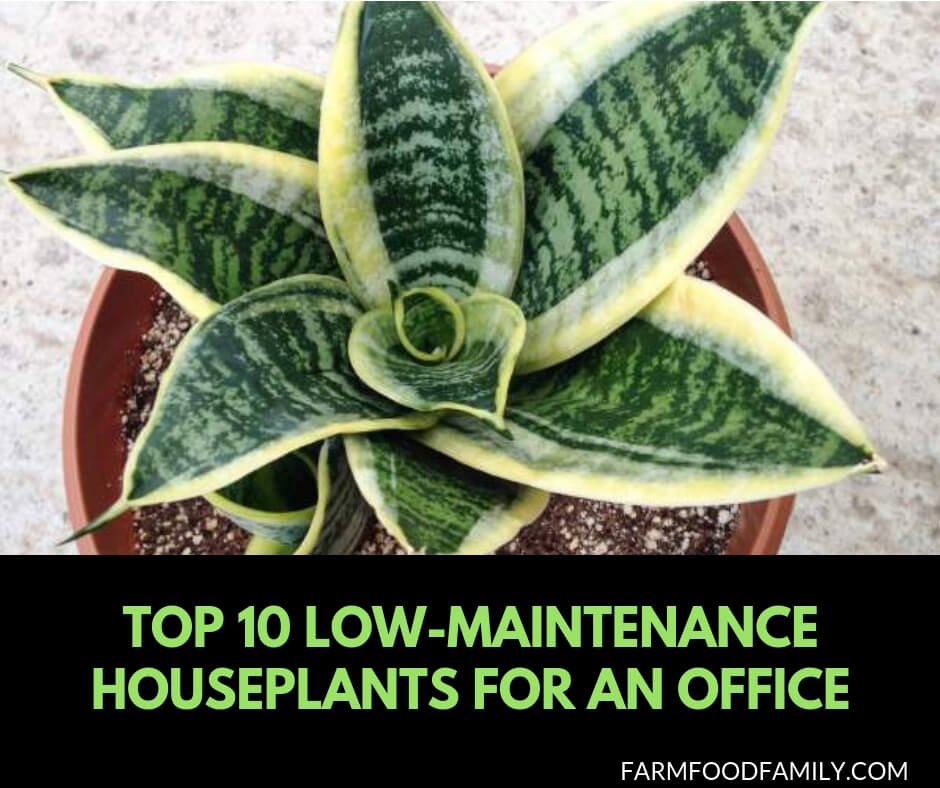Working in a typical office setup can become mundane. By adding a low maintenance houseplant, your work space will be less drab and become the envy of the office.
Caring for a houseplant is fairly simple. In general, most houseplants do just fine with a light watering once per week, florescent or indirect natural lighting, and good air circulation – basically, all things found within an office.
Houseplants help create a peaceful working environment and improve the office’s overall air quality by removing toxins such as benzene, formaldehyde, and trichloroethylene.

#1. Pothos

The term “houseplant” refers to several different species of plants. The most common houseplant found in an office is Epipremnum – more commonly known as “Pothos” or “Devil’s Ivy.”
Pothos plants are very hardy and can be trained to climb up or allowed to trail down the side of a desk.
They require little light and prefer to dry out completely between waterings.
To provide some humidity, mist these plants twice a week.
#2. Snake Plant

Sanservieria, more commonly know as “Snake Plant” or “Mother-In-Law’s Tongue,” is often used to liven up an otherwise dreary office.
With its variegated foliage and prominent growth habit, this houseplant adds a sense of flair to the office.
The leaves come in a variety of variegated patterns and can grow to be very tall with little attention.
This plant prefers to be pot bound, so there is no need to repot annually. Lighting is no issue with a snake plant because it will survive in both the brightest and dimmest of environments.
#3. Peace Lily

Spathiphyllum, also known as “Peace Lily” or “Closet Plant,” provides the office with something unique – flowers! Peace lilys perform best in a well-lit area where humidity can be provided.
A sufficient level of humidity can be achieved by misting or by placing a tray filled with water and pebbles beneath the plant’s pot. The pebbles prevent direct contact between the pot and water, which can cause root rot.
Peace lilys also prefer to not dry out completely; if an inadequte amount of water is being recieved, this plant will let you know by drooping its leaves. Not to worry though! The leaves spring right up after a good soaking.
#4. Spider Plant

Chlorophytum comosum, better know as “Spider Plant” is known for is long, slender foliage.
This easy care houseplant will send out shoots of new plants, which can be left on the main plant or removed to grow new plants (which is a great way to spread plants among your coworkers).
Spider plants require very light watering – once every two weeks is sufficient – as well as moderate lighting.
#5. Aloe

Aloe Vera, or more simply Aloe, can be a very useful plant to have in the office. Its bright green, succulent leaves are filled with a sap that can be used to treat a variety of ailmets, ranging from sunburns to paper cuts.
Once applied, this sap relieves pain and aids in healing. Because aloe is a succulent, it requires little watering (water is stored in its leaves).
With moderate to bright indirect light, an aloe plant can grow rather large in a short period of time. If it begins to outgrow your office, trim it back and offer the cut-off pieces to your coworkers.
#6. Madagascar Dragon Tree

Dracaena marginata, more commonly known as the “Madascar Dragon Tree,” offers those with larger offices a vertical focal point.
The dragon tree has dramatic, long, spiked green foliage that is often outlined with a deep shade of red.
This plant prefers to remain moist, so try not to let it dry out. With low light, its variegations tend to become more definitive.
#7. Ponytail Palm

Beaucarnea Recurvata, or “Ponytail Palm,” is a slow growing desert plant.
It requires little water – once every 10 days will suffice – and bright light. Because of its slow growing nature, this plant is often chosen by those who have limited office space.
See more: Types of indoor palm tree
#8. Diffenbachia

Dieffenbachia Species plants are one of the most commonly chosen plants for both the home and office due to its elliptically-shaped leaves.
This plant prefers moist soil, so watering twice a week is suggested and low to moderate levels of light are preferred.
#9. Purple Heart

Setcreasea purpurea, also known as “Purple Heart,” is a rapid-growing plant that is often used to add a splash of color to the office.
This purple-foliaged plant grows magnificently as a hanging plant, but performs just as well as a trailing plant.
Place purple heart in the sunniest window of the office and water regularly.
#10. Christmas Cactus

Schlumbergera, or “Christmas Cactus,” offers a tropical look to the workplace due to its jagged leaves and brightly colored flowers. This plant’s common name is derived from the time of year it most likely flowers – Christmas.
To induce flowering, provide up to 12 hours of darkness and temperatures around 50F daily beginning in September until buds are set.
The flowers of Christmas cacti come in a variety of colors, such as bright pink, white, red, and salmon. Allow this plant to dry between watering.
Selecting a houseplant to grow in your office can be a daunting task to a novice gardener. Thanks to resources such as the internet and local agricultural extension offices, growing any plant indoors can be successful.
To acclimate yourself to this new endevor, begin by selecting plants that require little watering and care, such as cacti and succulents. With patience and minimal effort, in no time at all your office will be the envy of your coworkers.

